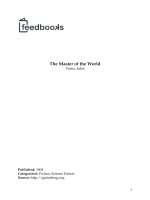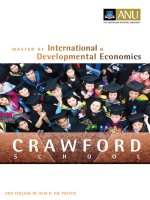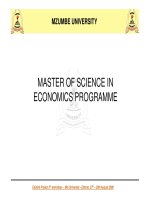SAURASHTRA UNIVERSITY RAJKOT MASTER OF ARTS (ECONOMICS)CHOICE BASED CREDIT SYSTEM COURSE OF STUDIES SYLLABUS (A draft of CBCS courses in M.A., Economics submitted for Revision of Curriculum to be executed from ,June, 2010)ByDEPARTMENT OF ECONOMICS SA doc
Bạn đang xem bản rút gọn của tài liệu. Xem và tải ngay bản đầy đủ của tài liệu tại đây (383.96 KB, 120 trang )
1
SAURASHTRA UNIVERSITY
RAJKOT
MASTER OF ARTS (ECONOMICS)
CHOICE BASED CREDIT SYSTEM COURSE OF STUDIES
SYLLABUS
(A draft of CBCS courses in M.A., Economics submitted for
Revision of Curriculum to be executed from ,June, 2010)
By
DEPARTMENT OF ECONOMICS
SAURASHTRA UNIVERSITY
RAJKOT
2
DEPARTMENT OF ECONOMICS
SAURASHTRA UNIVERSITY
RAJKOT
M.A. (Economics) CBCS Course
ABOUT CBCS IN M. A. ECONOMICS
Economics is a science of choice. Its main function is to satisfy human choices in the
context of availability of sources to satisfy these. In this context , this is most popular
definition of economics, “ Economics is a science which studies human behavior as a
relationship between ends and scarce means which have alternatives uses.” Choices are
related with the available alternatives.
Development process is linked with the choices. There are various types of choices, like,
private and public choice, individual and collective choice, economic and social choice,
production and consumption choice and many more types of choices. In this context we
can say that the choice based higher education system is one step ahead towards need
based and development oriented education. Let we briefly narrate this in the context of
M.A. Economics.
Choice Based M.A. Economics ( CBMAE) is very important in the subject considering
its global, practical and useful important. In CBMAE, first of all we have to create a
choice for the subject. Then we have to plan to satisfy the choice by providing the
appropriate frame work of the subjects. So here we follow the UGC guide lines for
CBCS in CBMAE. We have classify the subjects in Core courses, Elective courses and
multidisciplinary subjects. We have choose these subjects according to predetermined
important criteria’s. The core subjects of CBMAE , should be base, inevitable and
possess top most important in mainstream economics. The elective subjects of CBMAE
should be advanced, professional, employment oriented and should have contemporary
importance in local to global scenario. The multi disciplinary subjects in CBMAE should
be some what different than the traditional and modern economics subjects and linked
with the other faculty or disciplines of the arts faculty. Considering these norms , we have
choose the core, elective and multidisciplinary subjects for CBMAE.
Structure of Courses:
12 Core courses , 08 Elective \Optional courses and 2 Multi Disciplinary courses,
having a four credits of each course and each course will take 60 hours of teaching time
in each term. 100 marks per paper in which 70 marks external and 30 internal marks,
3hours of 70 marks at semester end exam.
Structure of Question Paper
i) In all 4 questions are to be asked.
ii) Two Essay type questions, each with internal option, carrying 20 marks each
iii) One question of 20 marks covering all units, consisting of 15 questions for short
answers from which 10 are to be attempted.
iv) Last question consisting of 10 MCQ type questions based on all units and will
carry 10 marks
3
STRUCTURE OF THE PROGRAMME:
(I) The M.A. Programme consists in four semesters
(II)There will be four types of courses
(1) Core courses 12
(2) Elective courses 06
(3) Interdisciplinary courses 02
(III) For core, elective and interdisciplinary courses as they are formed as theory courses
, there will be four hours classroom teaching per week and fifteen week work in a
semester. For one hour classroom work per week one credit is to be assigned . For each
semester there will be five theory courses and one skill oriented course. For skill oriented
course there will be two hours of class room work and two credits to be assigned.
For each semester the hours per week and credit will be assigned as under:
Semesters Theory courses Skill oriented
courses Hours per
week
credits course Hours per
wek
Credits
Semester-I 05 20 20 01 02 02
Semester-
II
05 20 20 01 02 02
Semester-
III
05 20 20 01 02 02
Semester-
IV
05 20 20 01 02 02
Total 20 80 80 04 08 08
The entire programme will contain 24 courses,88 hours class room work, and 88 credits.
(IV) For theory courses there will be two types of examinations
(I) The external examination
(II) Internal evaluation
(V) The external examination will be of 70 marks of each course and internal
examination will be of 10 marks and 20 marks will be assigned divided into 10+10, for
writing and presentation
4
(VI) The semester wise distribution of theory and skill oriented courses will be as follow:
Semester -I
Core semester -3
Elective courses -2
Semester -II
Core semester -3
Elective courses -2
Semester -III
Core semester -3
Elective courses -1
Interdisciplinary course-1
Semester -IV
Core semester -3
Elective courses -1
Interdisciplinary course-1
5
Structure of the CBCS in : Economics: First Semester
Subject
Code
Title of
Course
Course
credit
No.
of
hours
per
week
Weightage
for Internal
examination
Weightage
for
Semester
examination
Total
marks
Duration
of
semester
end
exam. In
hours
Core
courses
Oct-01 Micro
Economics
04 04 30 70 100 03
0ct-02 Macro
Economics
04 04 30 70 100 03
0ct-03 Public
Economics-1
04 04 30 70 100 03
Elective
courses
Ect-01 Financial
Economics
04 04 30 70 100 03
Ect-01 Information
Technology
and data
Analyses
04 04 30 70 100 03
Ect-01 Frame work
and structure
of Industrial
Economics
04 04 30 70 100 03
Ect-02 Economics
of
Infrastructure
04 04 30 70 100 03
Ect-02 Theory of
Economic
Growth
04 04 30 70 100 03
Ect-02 Theories of
demography-
1
04 04 30 70 100 03
6
Name of the department: Economics, Second Semester
Subject
Code
Title of
Course
Course
credit
No.
of
hours
per
week
Weightage
for Internal
examination
Weightage
for
Semester
examination
Total
marks
Duration
of
semester
end
exam. In
hours
Core
courses
Oct-04 Theories of
Duistribution
and Welfare
Economics
04 04 30 70 100 03
0ct-05 Advanced
Macro
Economic
Analyses
04 04 30 70 100 03
0ct-06 Public
Economics-2
04 04 30 70 100 03
Elective
courses
Ect-03 Industrial
Economics of
India
04 04 30 70 100 03
Ect-03 Theory of
Economic
Thought
04 04 30 70 100 03
Ect-03 Managerial
Economics
04 04 30 70 100 03
Ect-04 Theories of
Economic
development
04 04 30 70 100 03
Ect-04 Development
of
Infrastructure
: Problems
and Policies
04 04 30 70 100 03
Ect-04 Indian
Demography-
2: :problems
and policies-
04 04 30 70 100 03
7
Name of the department: Economics, Third Semester
Subject
Code
Title of Course Course
credit
No.
of
hours
per
week
Weightage
for Internal
examination
Weightage
for
Semester
examination
Total
marks
Duration
of
semester
end
exam. In
hours
Core
courses
Oct-07 Theories of
International
trade
04 04 30 70 100 03
0ct-08 Planning and
Development
Policies
04 04 30 70 100 03
0ct-09 Basic Theories
of environmental
Economics
04 04 30 70 100 03
Elective
courses
Ect-05 Agricultural
theories and
Practice
04 04 30 70 100 03
Ect-05 Mathematics for
Economists
04 04 30 70 100 03
Ect-05 Economics of
labor Theories
04 04 30 70 100 03
Ect-05 Recent Advances
in Micro
Economics
04 04 30 70 100 03
Inter\multi Disciplinary Courses
Ict-01 Vedic
Economics
04 04 30 70 100 03
Ict-01 Environmental
Problems &
Issues
04 04 30 70 100 03
Ict-01 Gandhian
Economics
04 04 30 70 100 03
Ict-01 Business
Economics
04 04 30 70 100 03
Ict-01 Mathematical
Economics
and
Econometrics
04 04 30 70 100 03
8
Name of the department: Economics, Fourth Semester
Subject
Code
Title of Course Course
credit
No.
of
hours
per
week
Weightage
for Internal
examination
Weightage
for
Semester
examination
Total
marks
Duration
of
semester
end
exam. In
hours
Core
courses
Oct-10 Issues I
International Trade
04 04 30 70 100 03
0ct-11 Policies for
sectoral
Development
04 04 30 70 100 03
0ct-12 Major
Environmental
Issues in India
04 04 30 70 100 03
Elective
courses
Ect-06 Agricultural
Problems and
policies
04 04 30 70 100 03
Ect-06 Basic Statistics for
Economists
04 04 30 70 100 03
Ect-06 Problems and
policies of labor in
India
04 04 30 70 100 03
Ect-06 Participatory
Development in
Reform process
04 04 30 70 100 03
Ect-06 Theory and
practice of Co-
operation
04 04 30 70 100 03
Inter\multi Disciplinary Courses
Ict-02 Relevancy of
kautilya
Economics
04 04 30 70 100 03
Ict-02 Problems and
Policies of
labor in India
04 04 30 70 100 03
Ict-02 Rural
Industrialization
04 04 30 70 100 03
Ict-02 Business
Environment
04 04 30 70 100 03
Ict-02 Research 04 04 30 70 100 03
9
Methodology
COURSE STRUCTURE
Semester –I
Core courses
OCT-01: Micro Economcs-1
OCT-02: Macro economics
OCT-03: public Economics
Elective Courses
ECT-01: Financial Economics
ECT-01 Information Technology and Data Analyses
ECT-01; Frame Work and Structure of Industrial Economics
ECT-02; Economics of Infrastructure
ECT-02: Theory of Economic Growth
ECT-02: Theories of Demography
Semester-II
Core Courses
OCT-04: Theories of Distribution and welfare Economics
OCT-05: Advanced Macro Economic Analyses
OCT-06: Public Economics-1
Elective Courses
ECT-03: Industrial Economics of India
ECT-03: Theory of Economic Thought
ECT-03: Managerial Economics
ECT-04: Theories of Economic Development
ECT-04: Development of Infrastructure : problems and policies
ECT-04:Indian demography: problems and policies
10
Semester-III
Core Courses
OCT-07: Theories of International Trade
OCT-08: Planning and Development Policies
OCT-09: Basic Theories of Environmental Economics
Elective Courses
ECT-05 :Agricultural Theories and Practice
ECT-05 : Mathematics for Economics
ECT-05: Mathematical Economics and Econometrics
ECT05: Economics of Labour Theories
ECT-05 :Recent Advances in Micro Economic Analysis
Inter\Multi Disciplinary Course
ICT-01 Vedic Economics
ICT-01 Environmental Problems and Issues
ICT-01 Gandhian Economics
ICT-01 Business Economics
ICT-01 Mathematical Economics and Econometrics
Semester-IV
Core Courses
OCT-10: Issues in International Trade
OCT-11: Policies for Sectoral Development
OCT-12: Major Environmental issues of India
Elective Courses
ECT-06: Agricultural problems and Policies
ECT-06:Basic static’s for Economics
ECT-06:Research Methodology
ECT-06: Problems & Policies of Labour in India
ECT-06: Participatory development in reform process
ECT-06: Theory and Practice of Co-operation
11
Inter\Multi Disciplinary Course
ICT-02: Relevancy of Kautilya Economics
ICT-02:Problems and Policies of labour in India
ICT-02: Rural Industrialization
ICT-02 : Business Environment
ICT-02: Research Methodology
12
M.A. (Economics) CBCS Course
Semester-I
Course(Core) No. 1 (OCT-01): Micro Economics-1
PREMBLE:
The main objective of this paper is to analyze the economic behavior of individuals,
firms and markets. It is mainly concerned with the learning the students in very
analytical and comprehensive manner with the various aspects of consumer behavior,
trends of costs, and the traditional and modern theory of markets and equilibrium of
firm.
Sem-1 (Core): Micro Economics-I
Teaching Hours : 60
Marks : 100: External : 70 and Internal : 30
Exam Time Allowed: 3 Hours for 70 marks at Semester end Exam
Structure of Question Paper
In all 4 questions are to be asked.
Two Essay type questions, each with internal option, carrying 20 marks each
One question of 20 marks covering all units, consisting of 15 questions for short
answers from which 10 are to be attempted.
Last question consisting of 10 MCQ type questions based on all units and will
carry 10 marks
Syllabus:
Unit – I
Nature of economic theory, assumptions and scope. Theory of demand: Utility, Indifference
curve, Revealed preference, Characteristics of goods approach, and consumer’s choice under
risk, Elasticity of demand-theoretical and empirical aspects.
Unit – II
Production function-Isoquants, returns to factor and returns to scale, factor substitution,
multiproduct firm, Cobb-Douglas production functions and its properties. Theories of costs,
Short-run and Long run Cost Curves. Derivation of cost functions from production functions.
Derived demand for factors.
Unit – III
Price and output Determination – Market Structures: perfect competition, monopoly, and
monopolistic competition, classical Models of Duopoly. Oligopoly - collusive and non-
collusive models.
Unit – IV
Alternative Theories of the firm-Baumol’s, Marris’s, Williamson’s, Bain’s, full cost, and
Behavioral models.
Suggested Readings
1. Henderson & Quandt : Microeconomic Theory, A Mathematical Approach.
2. Koutsoyiannis A.: Modern Microeconomics.
3. Heathfield & Wibe : An Introduction to Cost and Production Functions.
4. Layard & Walters: Microeconomics Theory
5. Naylor & Vernon : Microeconomics and Decisions Models of the Firm.
6. Ferguson, C.E.: Microeconomics Theory.
7. Dacosta, G.C. : Value and Distribution, Himalaya, 1992.
13
M.A. (Economics) CBCS Studies
Semester-I
Course (Core) (OCT-02) No. 2: Macro Economics
PREMBLE:
Macroeconomic or aggregative economic analyses have great importance in the
days of new economic reforms. So macroeconomics is very important to understand
macro economic policies to the students of this subject. Because it established the
functional relationship between the large aggregates. It is essential to analyze the
macroeconomic theoretical structure, which is considered for the proper comprehension
of the different issues and policies. Macroeconomics now is not only a scientific method
of analysis, but also a body of empirical economic knowledge. This paper equips the
students at the postgraduate level to understand systemic facts and latest theoretical
developments for empirical analysis.
Sem-1 (Core): Macro Economics
Teaching Hours: 60
Marks: 100: External: 70 and Internal: 30
Exam Time Allowed: 3 Hours for 70 marks at Semester end Exam
Structure of Question Paper
In all 4 questions are to be asked.
Two Essay type questions, each with internal option, carrying 20 marks each
One question of 20 marks covering all units, consisting of 15 questions for short
answers from which 10 are to be attempted.
Last question consisting of 10 MCQ type questions based on all units and will
carry 10 marks
Syllabus:
Unit-1: Macroeconomics and National Income Accounting
Macroeconomics- Methodology and subject matter- Rationale and importance of
aggregative analysis- Micro foundations of macroeconomics- Macroeconomic policy.
Definitions and concepts of national income- importance of national income analysis -
Measurement of national income- Keynesian approach to national income and post
Keynesian development- Circular flow- Flow of funds Different forms of national
accounting- Social accounting- Growth and sect oral breakdown- Problems in preparation
of social accounting - Use of national income and product accounting.
14
Unit-2: Monetary Theories.
The Quantity theory of Money: The Cambridge School- Keynesian General
theory- Post Keynesian theories: Friedman & Don Patinkin- New Classical School:
Rational expectation - J.R. Hicks on Classical and Keynes- Leijon Hufwood on
Keynesian economics and economics of Keynes- Recent developments- Neutrality of
money- Classical, Keynesian and post Keynesian views- Conditions of neutrality- Theory
of money and prices- Income theory of money and Liquidity theory of money-
Savings and Investment (S & I) equality: meaning, Classical, Keynesian approach
to S&I equality-Transmission mechanism- Integration of money and value theories-
Patinkin's real balance effect- Pigou's wealth effect.
Unit-3:
Theory of Investment
Meaning and determinants of investment- Marginal efficiency of capital (M
EC)
and investment: Long and short run shifts in investment functions- Interest-elasticity of
investment- impact of inflation- Influence of policy measures on investment- Multiplier
and acceleration: empirical evidence- Capital-output ratio approach.
Unit-4 Demand for Money and Supply of Money
The
concept- The Transaction demand- The Asset demand for money: Keynesian
and Classical approaches- Wealth approach- Post-Keynesian theories of demand for
money: Friedman's Restatement of Quantity theory, Modigliani's approach- Recent
development in the theory.
Supply of Money
The concept and constituents- Bank money and bank
multiplier- Money multiplier Exogenous and endogenous variations- Liquid assets and
potential money supply- Interest rates- Financial intermediaries and money supply-
Money supply and income expansion RBI approach- Effects of money supply- High
powered money- Inside and outside money- Control of money supply- Money market and
money market assets / instruments- Recent developments.
15
Basic Reading List
1. Ackley, G (1978). Macroeconomics: Theory and Policy, MacMillan,
New York
2. Dornbusch, R. and F. Stanley (1997). Macroeconomics, McGraw-Hill
Inc,
NewYork.
3.
Frisch, H.
(1983).
Theories of Inflation, Cambridge University Press,
4. Ghosh, B.
N.,
and Rama Ghosh (1993). Modern Macroeconomics:
Theory and
Policy, Himalaya Publishing.
5. Gupta, S.B: (1995). Monetary Planning in India, Oxford University
Press, New Delhi.
6. Gupta, G.S. (2001). Macroeconomics: Theory and Applications, Tata
McGraw-Hill publishing Company Ltd., New Delhi.
7.
Gurley J. and E.S. Shaw (1960). Money in a Theory and Finance, Brookings
Institution,
Washington.
8. Hall, R.E. and J.B. Taylor (1986). Macroeconomics, McGraw-Hill Inc.
New York.
9. Jha, R. (1991). Contemporary Macroeconomic Theory and Policy,
Wiley Eastern Ltd. New Delhi.
10. Laidler, D.E.W. (l977).Demand for Money, Theory and Evidence,
Dum-Don Valley, New
York.
11. Leijonhufwud, A. (1968). On Keynesian Economics and Economics of
Keynes, Oxford University Press, London.
12. Mankiw, N.G. and D. Romer (Eds.) (1991). New Keynesian
Economics, 2 Vols. MlT Press, Cambridge, Massachusetts, USA.
13. Mueller, M.G. (1966). Reading in Macroeconomics, Holt Rinehart &
Winston, N.Y.
14. Patinkin, D. (1965). Money, Interest and Prices, Harper & Row, New
York.
15. Lucas, R. (1981). Studies in Business Cycle Theory, M
IT
Press,
Cambridge, Massachuttes, USA. '
16. Taylor, L. (1983). Structuralist Macroeconomics, Basic Books, New
Longman
17.Blockhouse, R. and A. Salansi (Eds)(2000) Macroeconomic and the Real World (2
Vols) Oxford University Press, London.
18 Branson, W.A. (1989) Macroeconomic Theory and Policy, (3
rd
Edition) Harper and
Row, New Delhi.
19.Hejjdra B.J. and V.P. Frederisk (2001) Foundation of Modern Macroeconomic Oxford
University Press New Delhi.
20.Romer, D.L. (1996) Advanced Macroeconomic, McGraw Hill Company Ltd; New
York.
16
21.Scarfe, B.L. (1977) Cycles, Growth and Inflation. McGraw Hill Ltd; New York.
22.Shapiro, E. (1996) Microeconomic Analysis Galagotia Publications, New Delhi.
23.Surrey, MJC (Ed) (1976) Macroeconomic Themes, oxford University Press, Oxford.
24.Reddy, Y.V. (2000): A Review of Monetary and Financial Sector Reforms in India -
Central Bank's Perspectives, UNSPD New Delhi.
25.Gupta R.D. (1990) Keynes and Post - Keynesian Economics.
26.Chick Victoria (1995) Macroeconomic after Jeynes.
27.Brahmanand P.R. (1980) Growth less inflation by the means of stockless money.
28Rudra Dutta & Sunderam KPM. (2002) Indian Economy. S. Chand, Delhi.
17
M.A. (Economics) CBCS Studies
Semester-I
Course (Core)(OCT-03) No. 3: Public Economics
PREMBLE:
There is specific role of the state in economic development. It has changed over
time. The Public finance is very important subject t to analyze the role of the Government
in the context of fiscal behavior. It has been applied to the package of those policies and
operations which involve the use of tax and expenditure measures while budgetary policy
is an important part to understand the basic problems of use of resources, distribution of
income etc. There is wide and vast area of the subject. It analyzes the public revenue and
expenditure trends and programmes, budgetary procedures, stabilization instruments debt
issue levels of government etc., which raise a spectrum of issues arising from the
operation of these institutions. Further the existence of externalities concern from
adjustment in the distribution of income and wealth etc. require political processes for
their solution in a manner combines individual freedom and justice. This paper combines
thorough understanding of fiscal institutions with a careful analysis of the issues, which
underline budgetary policies in general, and Indian experience in particular.
Sem-1 (Core): Public Economics
Teaching Hours: 60
Marks: 100: External: 70 and Internal: 30
Exam Time Allowed: 3 Hours for 70 marks at Semester end Exam
Structure of Question Paper
In all 4 questions are to be asked.
Two Essay type questions, each with internal option, carrying 20 marks each
One question of 20 marks covering all units, consisting of 15 questions for short
answers from which 10 are to be attempted.
Last question consisting of 10 MCQ type questions based on all units and will
carry 10 marks
18
Syllabus:
Unit-1: Introduction, Failure of the Market Mechanism and Need for
Government Intervention
Role of government in organized society, overview of modern public economics -
government in a mixed economy: public and private sector, government as a tool for
implementing the planning process. Market failure-imperfections, decreasing costs,
monopolies, externalities, concepts of free riders, spill-over effect, types of goods and
their characteristics, public, private, mixed, merit, common property resourcesluation
Unit-2: Public Choice: Allocation of Resources
Private & public mechanism for allocating resources; Problems for allocating
resources,
contributions of Musgrave.
Efficient provision of private social mixed and merit,
Samuelson’s “Same Price” rule, impossibility of decentralized provision of social goods
mixed goods, bargaining in small group,
allocation in the budget,
Principle of maximum social advantage, Pigovian corrective taxes, Coasian bargaining -
common property resources: demand revealing schemes for public goods,
problems of
preference revelation and aggregation of preferences, voting systems, Arrow
Impossibility Theorem, economic theory of democracy, politico-eco-bureaucracy,
problems of preference revelation and aggregation of preference, Dr. A.K.Sen’s
contribution in public choice theory.
Unit-3: Rational for Public Policy:
Problem of instability in an economy, role of monetary and fiscal policies in bringing
stabilization in the economy, Distribution Policy-Meaning, Does equity belong in
economics, allocation or distribution: Which comes first, approaches to distributive
justice, limits to redistribution, poverty alleviation-role of fiscal and monetary policies in
India in reducing distributional inequalities & regional imbalances. Allocation of
resources - Provisions of public goods, voluntary exchange models, Impossibility of
decentralized provision of public goods (contribution of Samuelson and Musgrave).
19
Unit-4 fiscal policy and theory of public expenditure.
Objectives & instruments of fiscal policy, impact of Fiscal policy (tax, expenditure and
debt) on allocation and efficiency, distribution and redistribution, stabilization and
growth, interdependence of fiscal & monetary policies, Wagner’s law of increasing
state activities, Wiseman - peacock hypothesis - pure theory of public expenditure -
structure and growth of public expenditure.
Basic reading list:
1.Buchanan J.M. (1970) The Public Finances, Richard D. Irwin, Home Wood.
2.Goode R (1986) Govt. finance in Developing Countries, Tata McGraw Hill New Delhi.
3.Houghton J.M. (1970) The Public Finance selected Readings, Penguin, and
Harmondsworth.
4.Jha, R. (1998) Modern Public Economics, Routledge, London.
5.Menutt P. (1996) The Economics of Public Choice Edward Elgar, U.K.
6.Musgrava R.A.(1956) The Theory of Public Finance, McGraw Hill Korakhuse, Tokyo.
7.Musgrava R.A. and P.B. Musgrave (1976) Public Finance in Theory and Practice,
Macgraw Hill, Kogukhusa, Tokyo.
8.Shoup,C.S. (1970) Pubic finance, Aldine Chicago.
9.Shome P. (Ed) (1995) Tax Policy Hand Book Tax Division, Fiscal Affairs Department,
International Monetary Fund Washington, D.C.
10.Auerbach, A.J. and M Feldstern (Eds) (1985), Handbook of Public Economics, Vol-I,
North Holland, Amsterdem.
11.Bhatia, H.L., (2003), Public Finance, Vikas Publishing House Pvt. Ltd., New Delhi
20
ELECTIVE COURSES
M.A. (Economics) CBCS Studies
Semester-I
Course (Elective)(ECT-01) No.4.1: Financial Economics:
Preamble: The positive and significant role of financial institutions in the
process of growth and development has been very well recognized in the
literature and indeed has become more important during the last two decades
Sem 1 (Elective) Financial Economics
Teaching Hours: 60
Marks: 100: External: 70 and Internal: 30
Exam Time Allowed: 3 Hours for 70 marks at Semester end Exam
Structure of Question Paper
In all 4 questions are to be asked.
Two Essay type questions, each with internal option, carrying 20 marks each
One question of 20 marks covering all units, consisting of 15 questions for short
answers from which 10 are to be attempted.
Last question consisting of 10 MCQ type questions based on all units and will
carry 10 marks
Syllabus
Unit- 1: Meaning and Nature of financial economics and Role of
Financial System:
Definition of Financial economics and its nature, -Money and finance -
Money and near-money - Financial intermediation and financial
intermediaries - The structure of the financial system - Functions of the
financial sector - Indicators of financial development - Equilibrium in
Financial Markets - Financial System and Economic Development - Criteria
to evaluate assets: Risk and financial assets, types of risk, return on assets,
Risk - Return trade off - Valuation of Securities.
Unit-2: Structure of Interest Rates:
Theories of interest rate determination - Level of interest rates - Long period
and Short period rates - Term Structure of interest rates - Spread between
lending and deposit rates - Administered interest rates - Appropriate interest
rate policy.
U
nit-3: Financial Markets:
Role and structure of money market and capital market - Call money
market. Treasury bill market, commercial bill market including commercial
paper and certificate of deposits, Discount market - Government securities
market - Markets for derivatives: futures and options, and other derivatives
types, uses and pricing of derivatives - Primary and secondary market for
securities; SEBI: its impact on the working of capital market in India; IRDA
and its role in financial markets.
21
Unint-4: Mechanism of International Flow:
Exchange Rates - devolution and appreciation - Floating rate and pegged
exchange rate system - Risk hedging and futures in exchanges rates - international
liquidity Reforms in International financial systems for developing, countries - Foreign
director Investment in Indian Theory currency areas.
Basic Reading List:
RBI, RBI Currency & Finance Report, 2001 & Onwards
Hanson, J.A. Kathuria (1999): India: A Financial Sector for the twenty-four century,
Oxford University Press, New Delhi.
Goss, B.A, Yamey B.S. (1978), The Economic of Future Trading/
RBI (1995) Report of working of Monetary system in India, RBI, Mumbai.
Red Seth, A (2000), Open economy macroeconomics, Cambridge University Press.
RBI: (1991)(1998), Narsimham Committee Reposts, RBI, Mumbai.
Annual Report of SEBI and IRDA.
Machiraju, H.R. (1997), International financial markets in India, Wheelar Publishment
Allah bad.
Annual Reports of IMF, IBRD, IDA and ADB
World Development Report, 1999 to 2005.
— Bhole, L. M. (1999), Financial Institutions unci Markets, Tata McGraw
Hill Company Ltd., New Delhi.
— Bhole, L. M. (2000), Indian Financial System, Chugh Publications,
Allahabad.
— Edminster, R. O. (1986), Financial Institutions, Markets and
Management, McGraw Hill, New York.
— Goldsmith, R. W. (1969), Financial Structure and Development, Yale,
London.
— Hanson, J. A. and S. Kathuria (Eds.) (1999), India: A Financial Sector for
the Twenty-first Century, Oxford University Press, and New Delhi.
— Harker, P. T. and S. A. Zenios (2000) (Ed.), Performance of Financial
Institutions, Cambridge University Press, Cambridge.
— Johnson, H. J. (1993). Financial Institutions arid Markets, McGraw Hill,
New York.
— Khan, M. Y. (1996), Indian Financial System, Tata McGraw Hill, New
Delhi.
— Machiraju, M. R. (1999), Indian Financial Systems, Vikas Publishing
House, New Delhi.
— Ohlson, J. A. (1987), The Theory of Financial Markets and Institution,
North Holland, Amsterdam.
22
M .A. (Economics) CBCS Studies
Semester-I
Course (Elective) (ECT-01) No.4.2: Information Technology and Data Analysis
Preamble: The computers have become very essential tools for data
analysis, Information processing, modeling and graphical presentation. The
advancements for PC software and declining prices of hardware are the key
factors for their widespread use in education, business and industry. This
subject needs to be added in the curriculum since the use of such software
lead to higher productivity.
The students of Master's programme in Arts will find this subject very
useful in getting the first hand information and skill about the popular PC
Software packages. They will also be able to use the Software for data
analysis, mode line, report, generation and graphical presentation.
Sem 1 (Elective) information technology and Data analyses
Teaching Hours: 60
Marks: 100: External: 70 and Internal: 30
Exam Time Allowed: 3 Hours for 70 marks at Semester end Exam
Structure of Question Paper
In all 4 questions are to be asked.
Two Essay type questions, each with internal option, carrying 20 marks each
One question of 20 marks covering all units, consisting of 15 questions for short
answers from which 10 are to be attempted.
Last question consisting of 10 MCQ type questions based on all units and will
carry 10 marks
Syllabus
Unit-1: Introduction to Information Technology:
History of development of computers and communication. Types of
computers: Analog, Digital and
Hybrid, varieties of personal computers and other microcomputers.
Computer Hardware - CPU memory, 10 Devices.
Latest 10 media and storage capacity-floppies, hard disk, MO disc, DAT,
CD-ROM, CD-R and CD writ able.
Unit-2: various package and programs
Computer Software-Operating Systems and Development packages,
Popular packages for word processing, spreadsheets, presentation and
databases.
Communication principles-Analog and Digital use of modems,
networking of computers-LAN, WAN, Networking Software.
Internet facilities-getting connection, accessing Internet facility, sending
mail, accessing databases and web pages, using other facilities of Internet.
Unit-3: Operating System:
Study of MS-DOS and Windows; Windows-95/2000
DOS commands for directory, files, editing, printing and other
miscellaneous tasks.
23
Windows Icons, dialogue boxes, control panel, taskbar explorer, File
management in Windows.
Built-in accessories-calendar, Address book, etc.
Unit-4 Word processing
Word Processing using MS Word. Document creation, modification,
Porting, exchange with other documents, formatting, search and replace,
spell checking, font selection and printing study and practice of all
formatting facilities of a word processing package.
Basic reading list:
— Computer Fundamentals by Sinha (P.K. (1992) BPS Publishers
— Illustrated MS DOS by Stultz BPS Publishers
— Learn Windows 95 in a day by Fuller BPS Publishers
— ABCs of MS Office 97 by Hart BPS Publishers
— SPSS/PC Reference Manual SPSS Incorporated
24
M.A. (Economics) CBCS Studies
Semester-I
Course (Elective) (OCT-01) No.4.3:
Industrial Economics: Structure, Conduct &
Performance
PREAMBLE: -
In the contemporary world with globalization and liberalization more and more
attention is being given to industry. This course intends to provide knowledge to the
students on the basic issues such as productivity, efficiency, capacity utilization and
debates involved in the industrial development of India. The objective is to provide a
thorough knowledge about the economics of industry in a cogent and analytical manner,
particularly in the Indian context. Paper of Industrial Economics structure conduct and
performance paper of Industrial Economics of India both cover all the objectives and
importance of the study of Industrial Development of India.
Sem 1 (Elective) Industrial Economics: Structure, Conduct and performance
Teaching Hours: 60
Marks: 100: External: 70 and Internal: 30
Exam Time Allowed: 3 Hours for 70 marks at Semester end Exam
Structure of Question Paper
In all 4 questions are to be asked.
Two Essay type questions, each with internal option, carrying 20 marks each
One question of 20 marks covering all units, consisting of 15 questions for short
answers from which 10 are to be attempted.
Last question consisting of 10 MCQ type questions based on all units and will
carry 10 marks
Syllabus
Module – 1
Industrial Economics framework and its problem
Concept of firm, types of firm, main objectives of the firm. Firm behavior active
and passive, profit maximization, scope of Industrial Economics.
Module – 2
Market Structure: -
Main components of the market sellers concentration, product differentiation, entry
condition, exit from the market, economies of scale market structure and profitability,
market structure and innovation.
25
Module – 3
Market Conduct: -
Market and product pricing, pricing theories and strategies, Investment expenditure
– its methods of evaluating investment expenditure merger acquisitions and collaboration
its theories and empirical evidences – its success and necessity Product diversification.
Module – 4
Market Performance: -
Growth of the firm, size of the firm, profitability of the firm, its constraints,
productivity efficiency and capacity utilization, its concept and measurement more in
context of Indian situation.
Basic Reading List:
1.Ahuliwala I.J. (1985) Industrial Growth in India, Oxford University Press, New
Delhi.
2.Barthwa R.R. (1985) Industrial Economics, Wiley Eastern Ltd. New Delhi.
3.Cherunilam F. (1994) Industrial Economics Indian Perspective (3rd Edition) Himalaya
Publishing House, Mumbai.
4.Desai B. (1999) Industrial Economics of Indian (3rd Edition) Himalaya Publishing
House, Mumbai.
5.Devine P.J. and R.M. Jones (1976) An Introduction to Industrial Economics, George
Alien and Unwin Ltd. London.
6.Government of India, Economic Survey (Annual)
7.Hay D. and D.H. Morns (1979) Industrial Economics: Theory and Evidence, Oxford
University Press, Delhi.
8.Kuchhal S.C. (1980) Industrial Economy of Indian (5th edition) Chaitnya Published
House, Allah bad.
9.Reserve Bank of India, Report on Currency and Finance (Annual)
10.Singh and A.N. Sadhu (1988) Industrial Economics, Himalaya Publishing House,
Bombay.
11.Naik Jyoti D. 'Udyog Ni Sthal Pasandgi', Visuki Printing.









